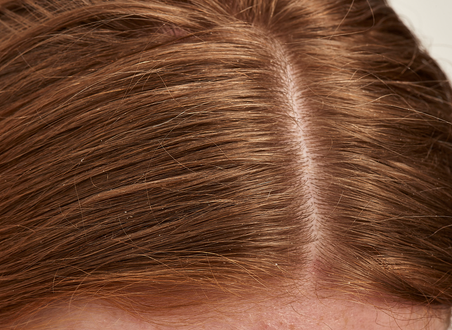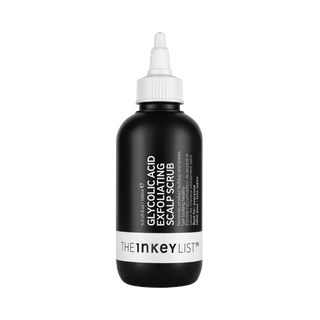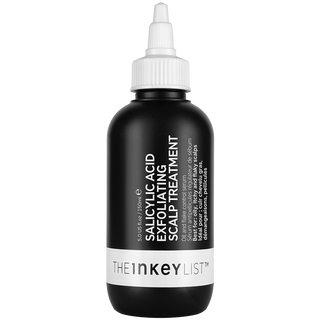Scalp Health 101

The scalp is literally the root of our hair health and can be the first place to show signs of imbalance which can contribute to the overall look and feel of your locks. From flakiness to excess oil, the scalp is equally as susceptible to problems such as imbalance, environmental factors and disorders.
WHAT IS THE SCALP?
We may be familiar with it as part of our head but we can get more scientific than that. The scalp is tightly bound to the galea aponeurotica, the aponeurosis that directly covers the skull. It is made up of layers: a superficial epidermis and a deeper dermis layer, where the hair bulbs are densely packed. Within these layers, capillaries bring nourishment to the follicles from the blood. In turn this secretes sebum, which ensures the protection and moisturisation of the hair and scalp itself.
The scalp also has its own microbiome containing a diverse mix of microorganisms including bacteria and yeasts which forms a layer of defense against external stressors. A balanced microbiome population equals good scalp health whilst conditions like rashes, dandruff and irritation occur when it goes out of whack.
WHY IS THE SCALP IMPORTANT?
So, it doesn’t just hold our hair follicles in place. The scalp is actually responsible for protecting the brain, not just through the presence of hair, but also through thermoregulation of the entire head. It filters the sun’s rays and blocks excessive heat dispersion in cold environments so it’s important to give it as much TLC as the hair itself.
SCALP CONCERNS
There are several ways the scalp can indicate that something is out of balance. Here are some of the most common concerns we hear at askINKEY:
DRY/FLAKY/ITCHY SCALP
Dryness, flakiness and itchiness often go hand in hand to create a scalp nightmare. Whilst the symptoms manifest in a similar way, there can be a number of different causes including:
- Lack of moisture - this can be caused by overwashing which strips the scalp of protective oils or colder temperatures and dry climates.
- Product build up - an accumulation of product in the hair, often combining with sebum and dead skin cells which can leave the scalp inflamed, flaking and itching
- Natural build up - an accumulation of dead skin, dirt, sweat and sebum.
- Fungal infections (such as malassezia), inflammatory skin conditions (such as seborrheic dermatitis), dandruff or other medical concerns.
- Contact dermatitis - reaction to products and treatments used.
DANDRUFF VS DRYNESS VS BUILD UPS
Whilst they may manifest in similar ways and form into a flaky itchy scalp, dandruff, a dry scalp and build up can stem from different causes.
As well as irritated, oily skin, dry skin, contact dermatitis, the major cause of dandruff is due to an immune response to a yeast called Malassezia. This naturally lives on our scalp and feeds on our sebum. This fungus can be increased by factors such as age, stress and hormones. The Malassezia produces oleic acid which can irritate the scalp and set off an immune response. This can lead to a rapid turnover of skin cells, forming flaky skin. Typically, dandruff flakes tend to be larger, oiler flakes, whilst dry scalp are smaller drier flakes.
To compare, build ups are more connected to products you use, or it can be a natural build up of dead skin cells, oil and dirt. Dryness of the scalp can be due to lack of moisture. However often, a dry flaky scalp can be caused by overproduction of oil from the sebaceous gland located near the hair follicles.
MEDICAL CONDITIONS
As with the skin, it may be a medical condition that’s the cause of flaking, irritation or dryness of the scalp or hairline. For example, scalp psoriasis is caused by the scalp going into overdrive, increasing cell turnover. This can result in thick, scaly plaques of skin which can get stuck in the hair. Depending on the severity, conditions like this can benefit from the use of an exfoliator such as the Salicylic Acid Exfoliating Scalp Treatment or may require consultation with a doctor/derm/trichologist who would be able to prescribe treatments.
OILY SCALP
An oily scalp is caused by your body naturally producing too much sebum from the glands in the follicles. These oils are normal and natural, but over production can be down to factors such as hormone imbalance, hair routine and products used.
Whilst it may sound counter-intuitive sometimes it’s better to wash your hair less frequently when you have an oily scalp as washing too often can strip the scalp of its natural sebum triggering it into overdrive and producing even more sebum.
THE INKEY LIST SCALP SAVIOURS
SALICYLIC ACID EXFOLIATING SCALP TREATMENT
As with the skin, Salicylic Acid is a hero ingredient for your scalp as much as your face! This lightweight serum helps to remove flakes and itchiness through gentle exfoliation of the scalp, balancing oil production and reducing redness.
Alongside Salicylic Acid, FLUIDIPURE™ 8G and PANTHENOL in this formula respectively help to reduce scalp’s redness and to hydrate and moisturise the scalp and hair. After 28 days of use, 100% of respondents felt their scalp and hair was less oily.
HOW TO USE: Use as a pre-shampoo treatment. Applied to wet or dry scalp.
Shake into the palm of your hand, massage hands together and use your fingertips to rub into your scalp. Apply enough to cover the entire scalp. Leave on for 10 minutes then wash hair as normal. Use 1 - 2 times a week.
GLYCOLIC ACID EXFOLIATING SCALP SCRUB
A gentle exfoliating scrub formulated with both chemical and physical exfoliators to help remove product build up and dead cells. This will leave your hair looking fresh and healthy. This unique formulation also helps to protect and balance the scalp’s microbiome and keep the hair follicles clean. Scalp exfoliation is vital to remove dead skin and product build up, giving your roots the chance to thrive and lift versus being weighed down.
Excess of buildup can disrupt the healthy function of the hair follicle and removing that buildup can encourage normal growth and roots to lift up.
HOW TO USE: Use as a pre-shampoo treatment. Apply to a wet or dry scalp Use the nozzle to apply directly onto scalp and use your fingertips to rub in. Apply enough to cover the entire scalp. Leave on for 10 minutes then wash hair as normal. Use 1-2 times per week. Use on separate occasions to Salicylic Acid Exfoliating Scalp Treatment to avoid any risk of irritation.
View all scalp treatments from THE INKEY List
TIPS TO PREVENT SCALP ISSUES
As well as targeted treatments, here are a few more ways you can keep your scalp in good health:
- Treat your scalp to its own routine alongside products that are aimed at your overall hair look and health.
- Experiment with the frequency you wash your hair. Overwashing can cause both dryness as well as overproduction of oil (despite what you’d assume!) whilst underwashing can result in product build up - find the balance in your routine. Generally, people with average to oily hair should wash every 1-2 days, whilst people with dry to damaged hair could wash every 3-4 days.
- If you experience itchiness, try removing products individually from your routine to see if they are causing a reaction in your scalp.
- It is important to wash your hair thoroughly with the right shampoo and conditioner for your hair type.
- Introduce a scalp exfoliator into your hair care routine, this will help to slough away dead skin cells and help maintain a healthy scalp skin cell turnover.
- Like with the skin, adjust your haircare routine with the seasons incorporating more moisture into the colder months which can dry out your scalp.
- Stop scratching - as much as it may be itchy or irritating, scratching at a flaky scalp will incur a shower of snowflakes across your shoulders.
Want to know more about hair health? Chat to our #askINKEY team now who’ll be happy to help build you a personalized hair care recipe or create your own routine today with our Recipe Builder.










